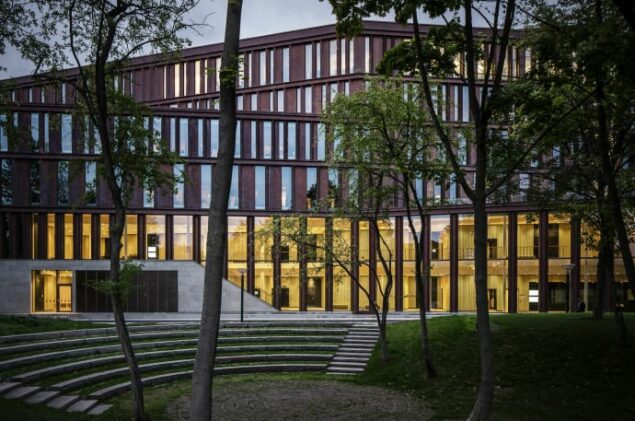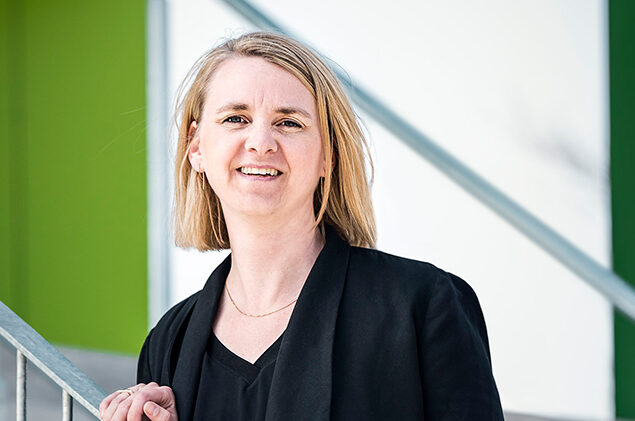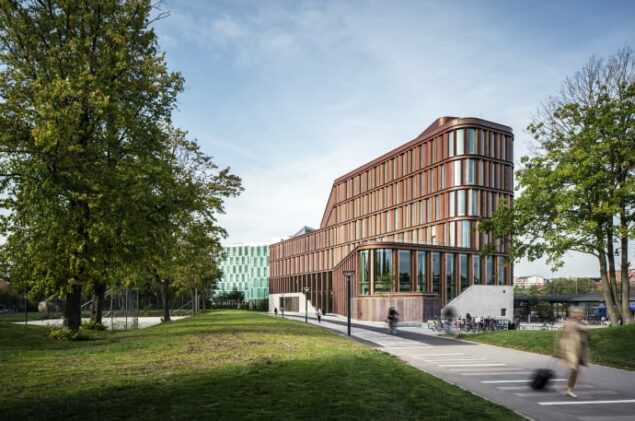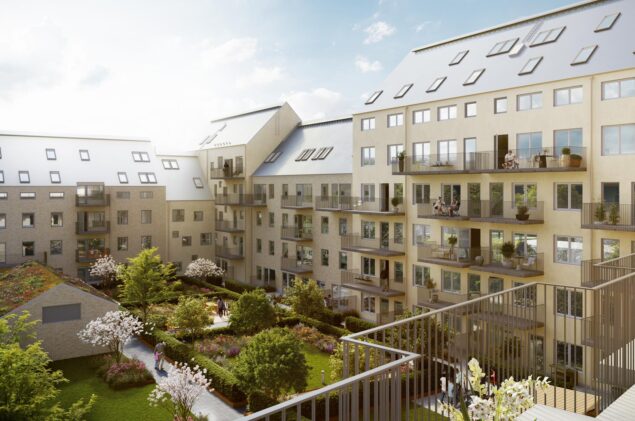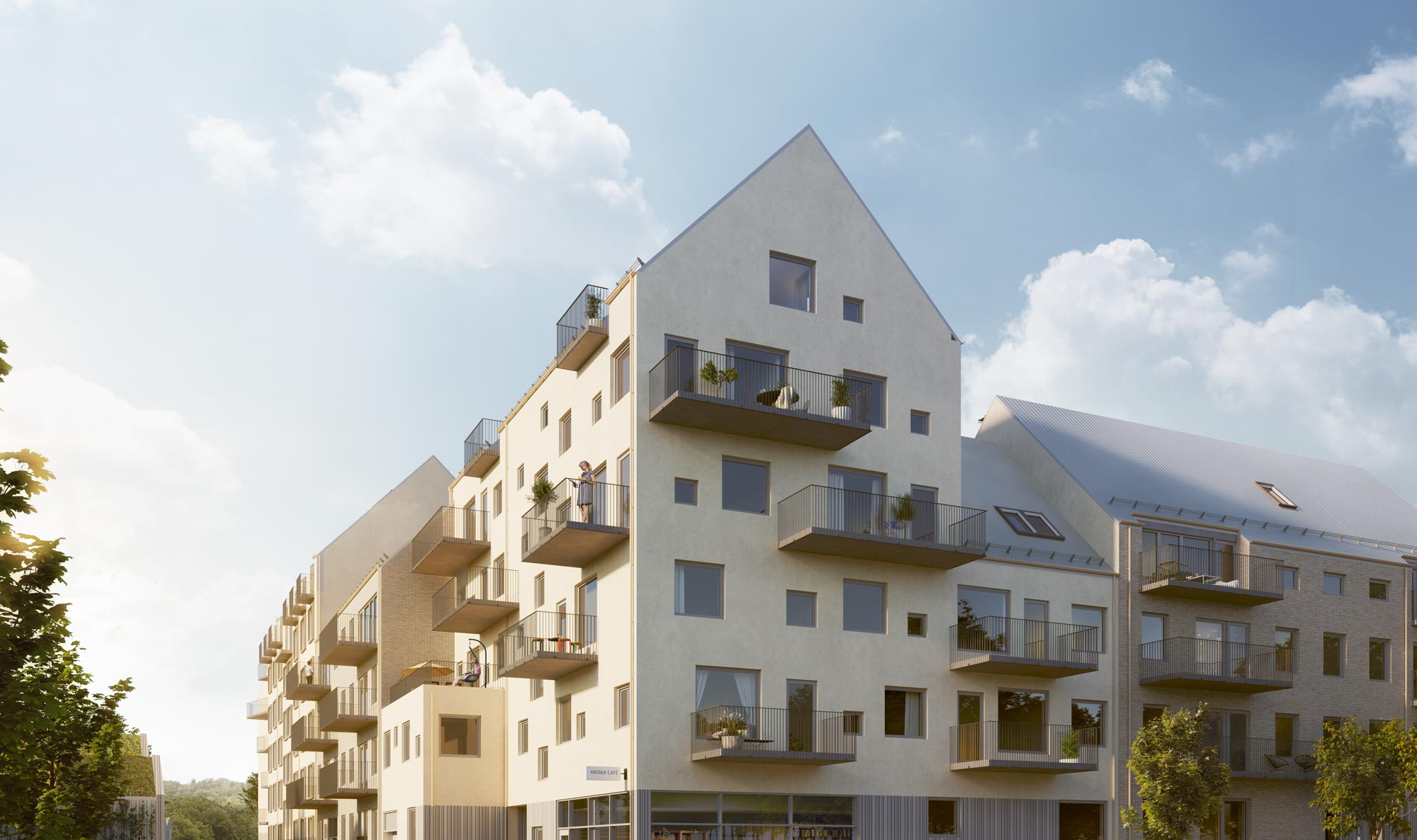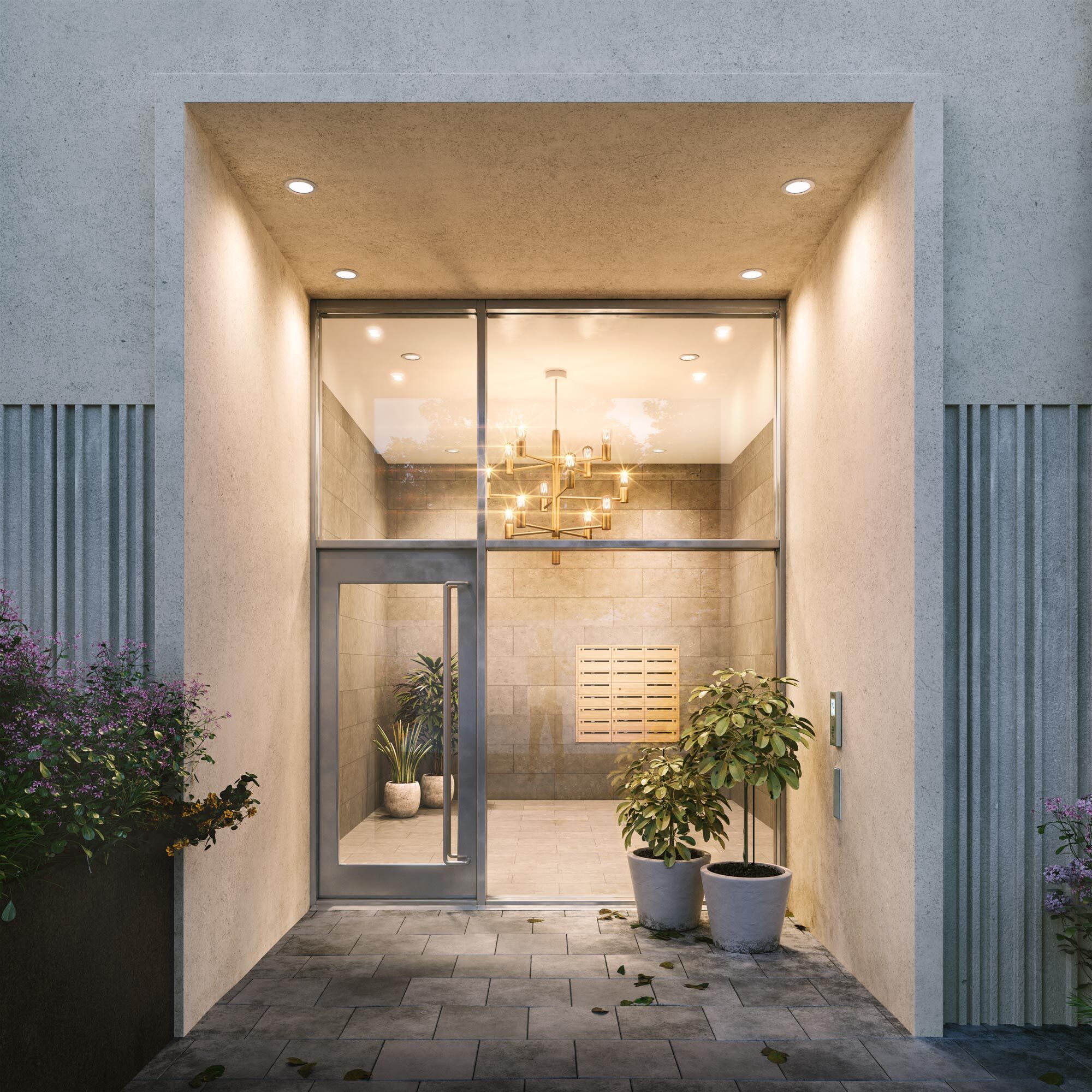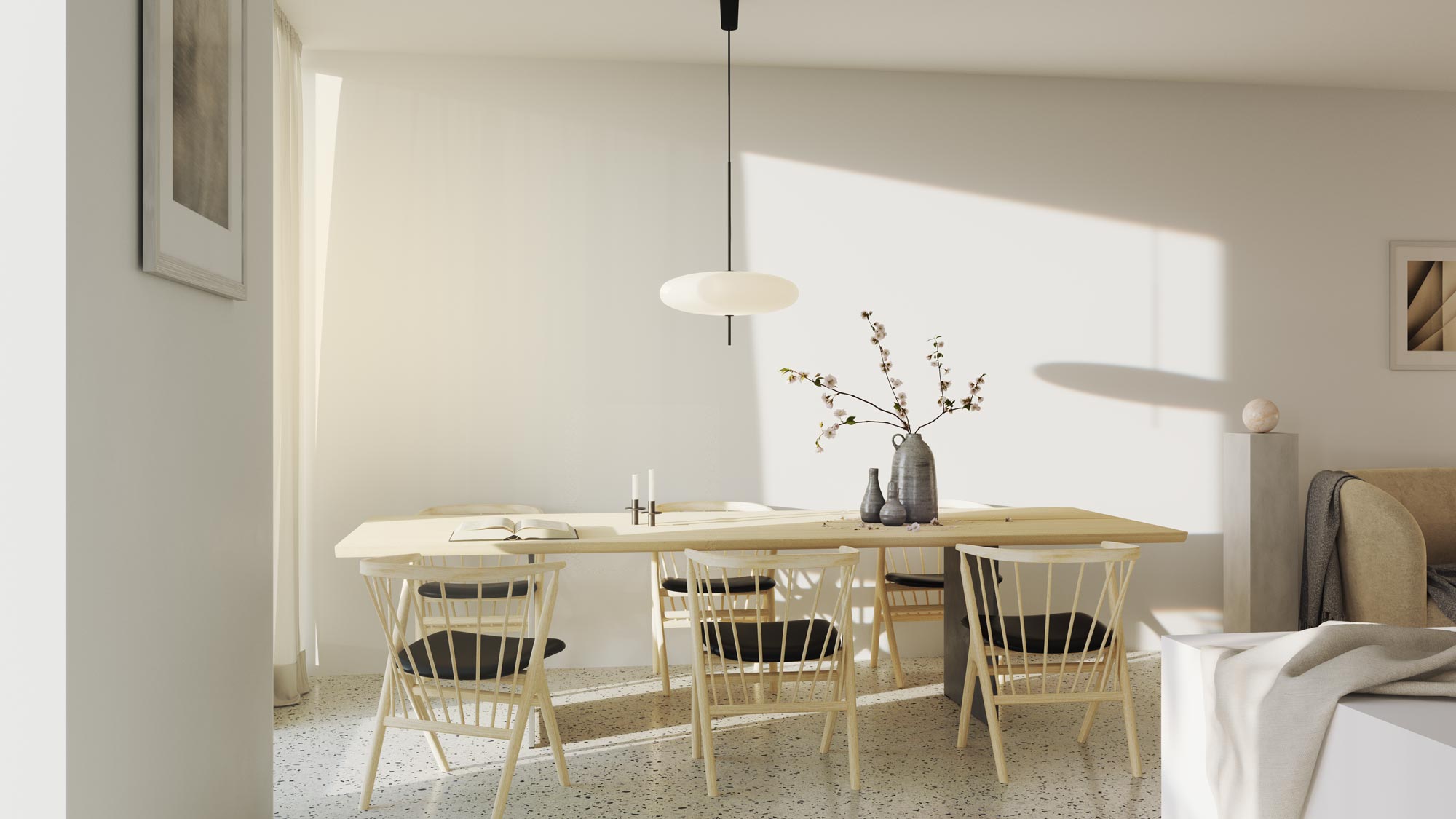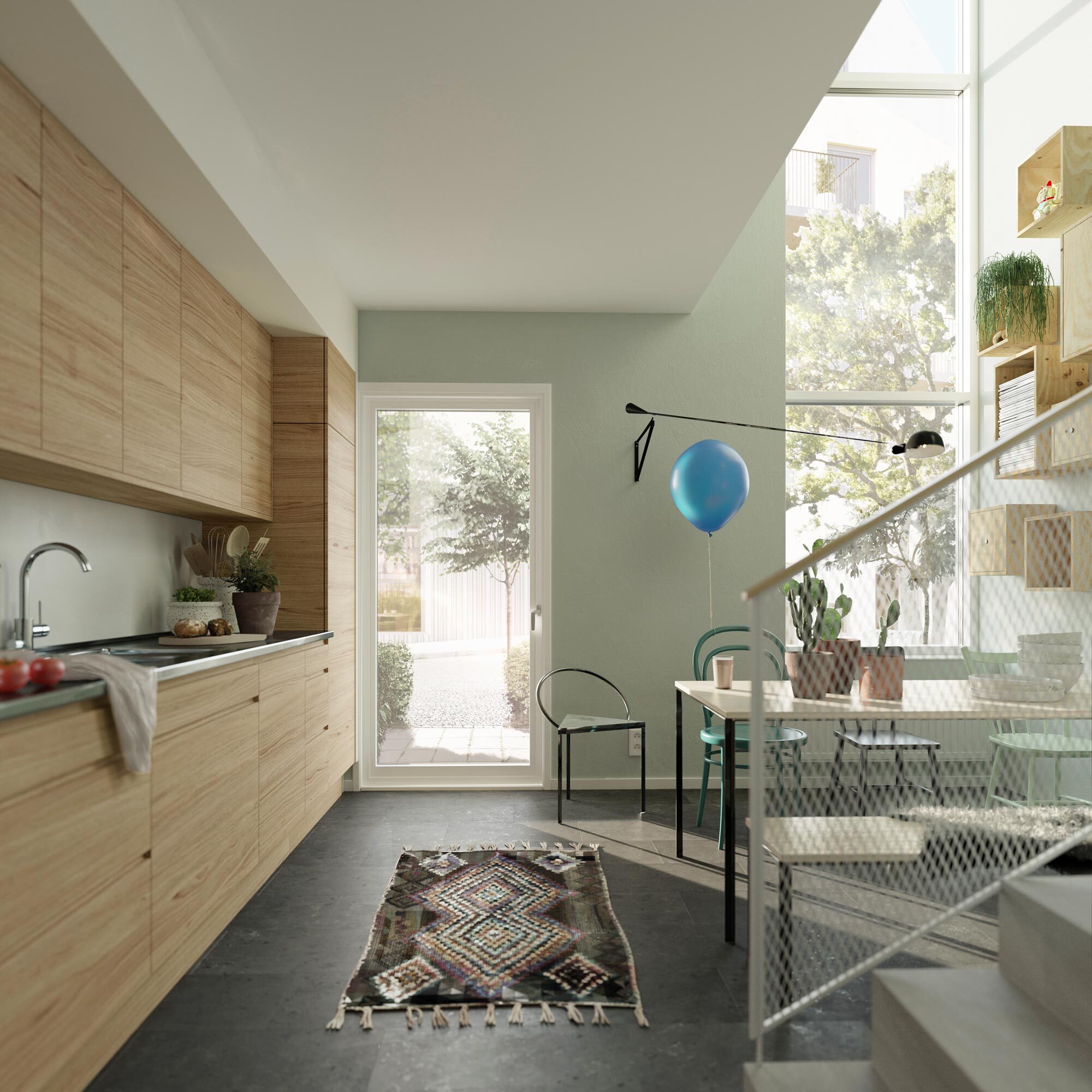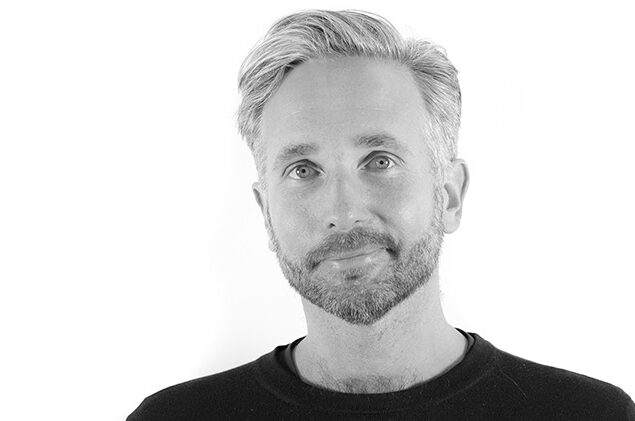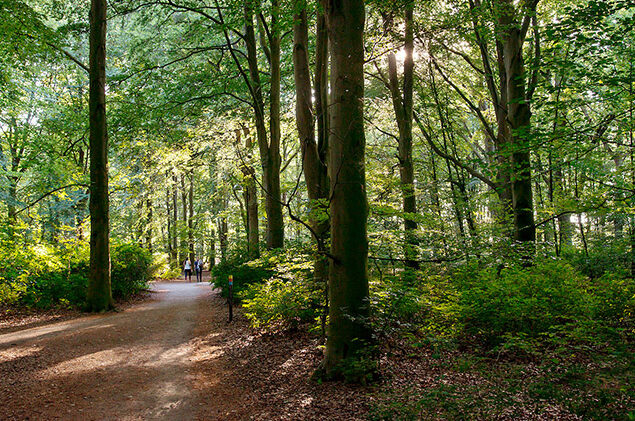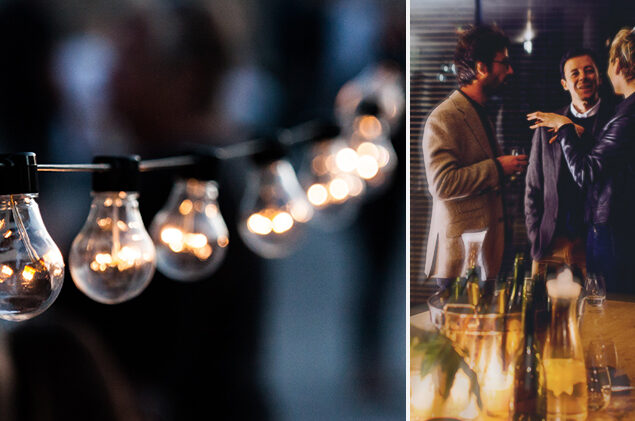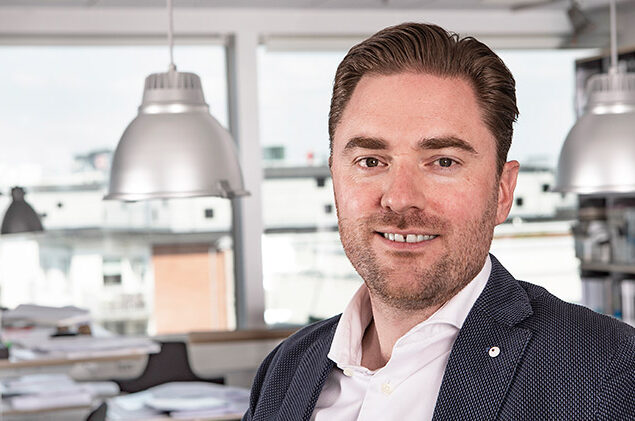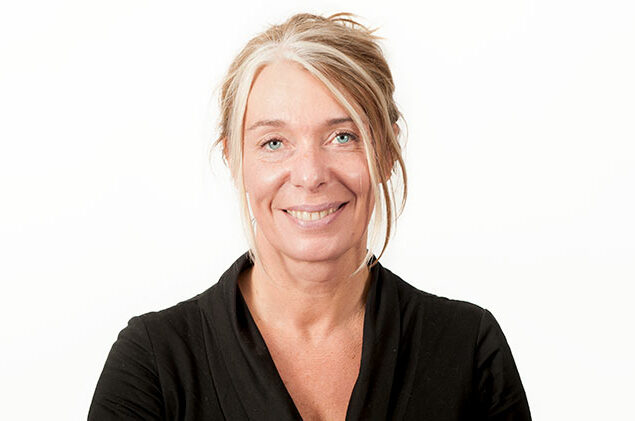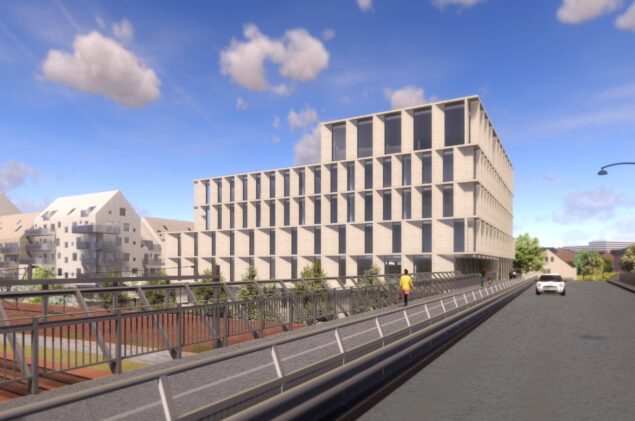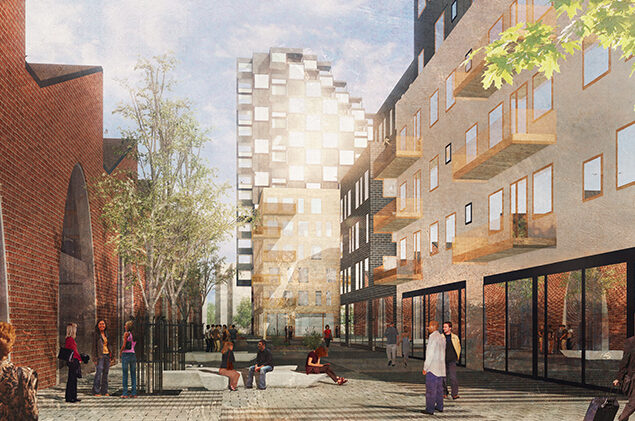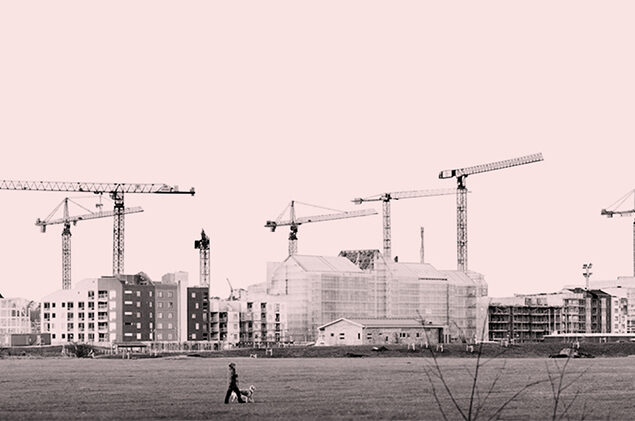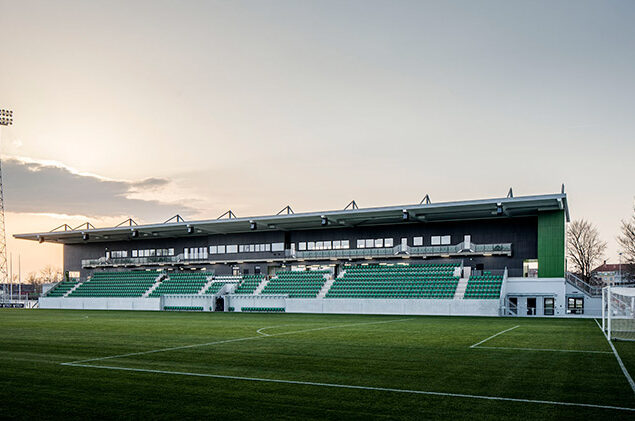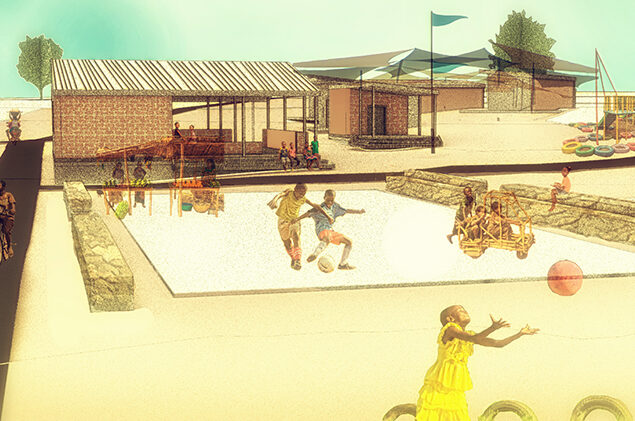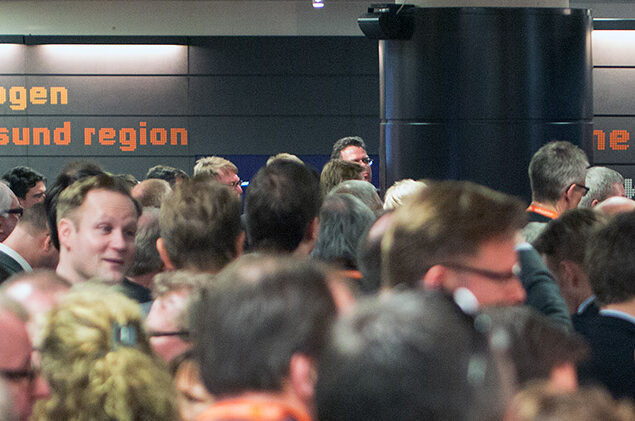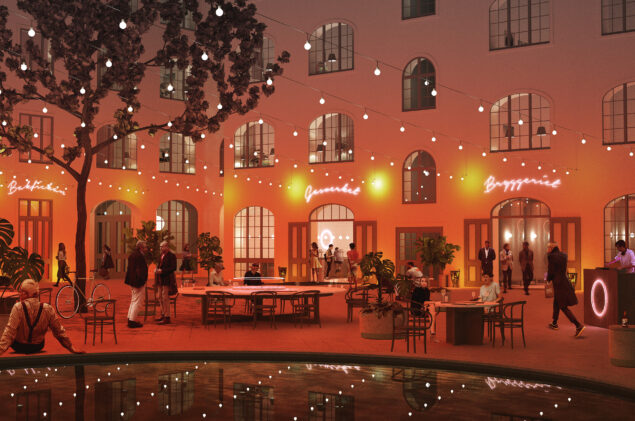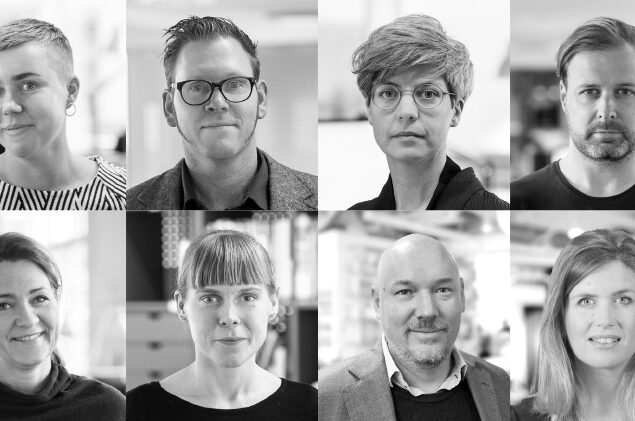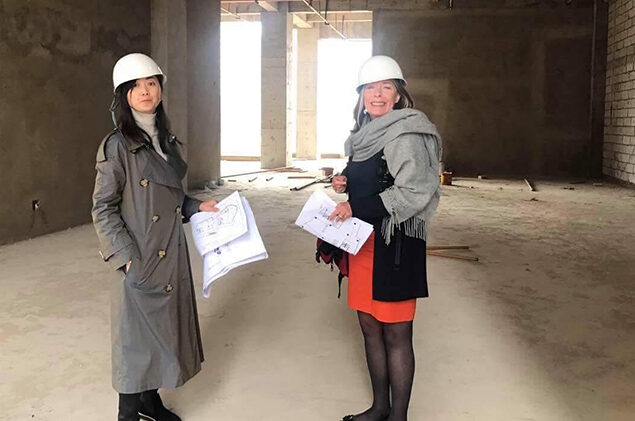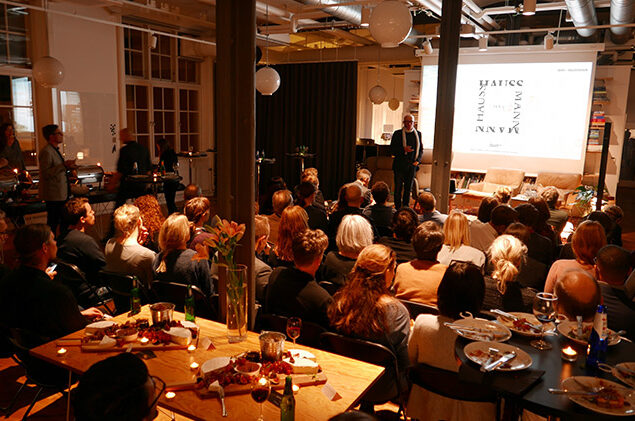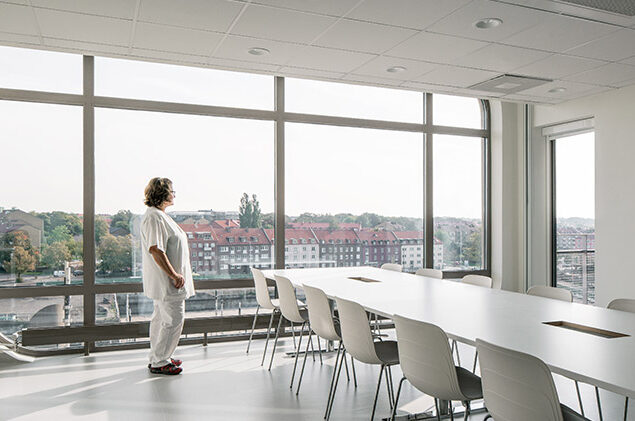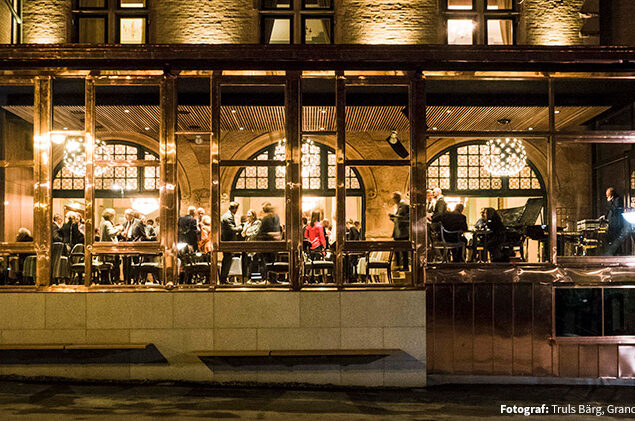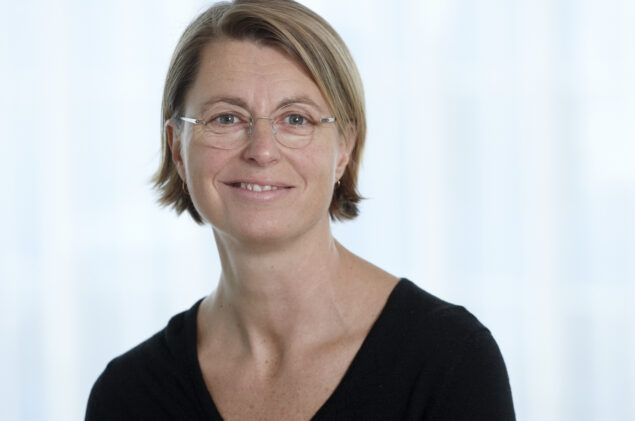2019-02-05
Axis office - new landmark in Lund, Sweden
For several years, work has been underway to create Axis' new office and now it is almost time to move in. The office consists of an office block that is designed according to the needs and wishes of the knowledge companies of the future.
Axis' new office in Lund will be the face of the company and consists of a continuous building that is divided into several building bodies of varying heights that interact with each other. The main entrance is located in the corner of the block facing the Ideon area and inside there is a large, bright common entrance square with space for exhibitions, meetings and mingling. A generous staircase leads to the Axis restaurant and further up to the common, green courtyard. The crowning glory is a skylounge and a spacious roof terrace with a 360-degree view of the Scanian landscape.
- "We wanted to create a profile building for Axis with an identity and strong character, which at the same time contributes to the city's diversity and social sustainability," says Andreas Blomberg, responsible architect at FOJAB.
The façade consists of a heavy natural stone-clad base with lightweight glass facades with white, angled slats on top. Once inside the building, visitors and employees are greeted by light, which is a recurring theme, while local, natural materials such as limestone and wood provide a warm and cozy feel. The office spaces are tailored to Axis' needs with both traditional cellular offices and open plan offices with plenty of light.
The block is part of the city planning office's objective to transform the Ideon area in Lund into a city with clear blocks and sunny meeting places for everyone who works, researches or visits Ideon.
- "What is being built now at Axis, but also at Medicon Village, is definitely a new chapter in the history of Ideon," says Marcus Horning, Director of Urban Development.
Axis takes care of its employees in many ways. In addition to an attractive work environment, each employee has their own Axis bike, which can be ridden straight down to a garage with shower and changing rooms, and a gym with a glass roof that connects the gym to the common areas above.
- The idea is for the office to feel a bit like a home at work, with plenty of areas for employees to meet and socialize," says Andreas Jentsch, supervising architect, FOJAB.
For further information:
Andreas Jentsch
andreas.blomberg@fojab.se
2018-12-20
FOJAB designed Lund's new district court - received Lund's urban development award
At the municipal council meeting on Thursday, FOJAB received the 2018 Lund Urban Design Award for the design of Lund's new district court.
- Based on the conditions of the site and a program with high demands on safety, function, environment and quality, we have designed a modern building, which at the same time well connects to Lund's building tradition, says Kjell Adamsson, architect and vice president of FOJAB.
In 1990, the Urban Development Prize was awarded for the first time. The prize was established by LKF, as a gift to the 1000-year anniversary of the municipality of Lund. The purpose of the prize is "to reward architects who have made a meritorious contribution to the development of the cityscape in the municipality of Lund. Particular consideration shall be given to architectural efforts that combine the development of the cityscape, good function for users and beauty values."
- I am proud and happy that our joint work has been recognized and it is a great honour to receive this award," concludes Stefan Johansson, architect at FOJAB.
Jury statement
Lund Urban Development Prize 2018 awarded to the architects of the New District Court! A complex building, with high demands on security and efficient flows, has been designed with a focus on functionality, dignity and transparency towards the surrounding urban space. Sophisticated and well thought-out choice of materials, high quality exterior and interior, gives an experience of sculptural dynamics and care from the whole to the details. A classically ordered architecture in modern costume, where the stepped building volume lands beautifully at the entrance square in the south, and the water mirror with its artwork meets Bjerredsparken in a refined way. The building makes a strong visual impression at close range, and at the same time forms a stately and important backdrop when viewed from Clemenstorget on the other side of the railroad. The New District Court will be an important cornerstone in the development of Lund C. As an ambitious and committed client, Specialfastigheter has attributed a high value to careful design and thus Lund has been enriched with an architectural jewel! We warmly congratulate FOJAB architects!
For further information:
Kjell Adamsson
kjell.adamsson@fojab.se
+46 708 – 83 80 82
Press:
Emma Schöön
emma.schoon@
+46 702 – 49 11 57
2018-12-19
New partner in FOJAB
At FOJAB's latest owners' meeting, Rebecca Saaby Mehlum was elected as a new partner. Rebecca Saaby Mehlum has been employed at FOJAB in Helsingborg since the office started in 2014, where she has been studio manager for the last two years.
- During her time as studio manager, Rebecca has taken great responsibility for the studio and FOJAB's position in Helsingborg. She has a natural and confident leadership of the group and works actively with the architecture discussion in her studio.
- Rebecca has integrity and trust with those around her. She works to build a common culture with the other offices and we believe that she is a key person in the company, says CEO Daniel Nord.
- I am grateful for the trust and it is of course nice to have nice words along the way in my work. Above all, I think it's both fun and important that I get to represent the Helsingborg office in this forum, and I'm very much looking forward to the work this will entail in the future," says Rebecca Saaby Mehlum.
Rebecca Saaby Mehlum
Architect SAR/MSA trained at the Royal School of fine Arts and Architecture in Copenhagen. Rebecca works with various architectural projects, including retail, animal care, sports and housing, such as Idrottsområde Kristianstad, various projects for IKEA and the housing project Mässhaken in Helsingborg.
For further information:
Daniel Nord
daniel.nord@fojab.se
+46 706 – 87 88 82
Press:
Emma Schöön
emma.schoon@
+46 702 – 49 11 57
2018-12-11
FOJAB designed Sweden's most modern court
Spacious, bright and impressive. This is how Lund's new district court has been described. As part of "the new Lund" west of the railroad tracks, the district court rises and gives the city a new silhouette. The Minister of Justice Morgan Johansson attended the inauguration and architect Kjell Adamsson from FOJAB gave a speech in which he described his thoughts and ideas when Lund District Court was designed. Since then, he and the other architects involved in the project have had several opportunities to show and tell about the architecture.
- Based on the site's conditions and a local program with high demands on safety, function, environment and quality, we have designed a modern building, which at the same time well connects to Lund's building tradition, says Kjell Adamsson, FOJAB.
The facade of the District Court is made of copper and glass, resting on a high limestone plinth. Based on the needs of the court, several entrances have been distributed throughout the building and there are terraces on the roof for the court's staff. Outside the court, a water mirror reflects the light and there is also a work of art by the artist Meta Isæus-Berlin.
Once inside, visitors are greeted by undulating wooden panels in oiled ash. There are four security zones for the public, prosecutors and jury members, other staff and detainees. The public areas are located on two levels that open up with large glass areas to the park outside.
- It was an honor to be entrusted with the design of Lund District Court. The process has been exciting and we are very proud of the result," concludes Kjell Adamsson, FOJAB.
For further information:
Kjell Adamsson
kjell.adamsson@fojab.se
+46 708 – 83 80 82
Press:
Emma Schöön
emma.schoon@
+46 702 – 49 11 57
2018-11-20
Klagshamn's riding facility nominated for Region Skåne's architecture prize
Region Skåne's architecture prize is awarded to a project that looks at the overall perspective of spatial connections. This can, for example, be about how the qualities of places are utilized and developed in new construction. Klagshamn's riding facility, designed by FOJAB architects, is one of the nominated entries for this year's award.
At the headland of Klagshamn, south of Malmö, there are shallow sandy beaches that are excellent for horseback riding. For a long time Klagshamns Ryttarsällskap was located here in a disused concrete factory. When the city of Malmö planned a new riding facility, it was natural to build on the same site as before, and FOJAB was commissioned to design the new riding facility.
The stables and riding hall have distinctive cohesive roof surfaces and the positioning of the buildings provides views of the Öresund.
Proven building techniques are combined with recycled brick features and innovative material choices.
- Klagshamn's equestrian facility has put the focus on a new generation of equestrian facilities that represent good animal and work environment together with sustainable materials, plenty of daylight and fresh air. We are both proud and happy that the facility is nominated for Region Skåne's architecture award, says Mats Molén, architect at FOJAB.
The winner of the architecture prize will be announced at Kreativa Skåne on November 22. Other nominees are Holma torg, Malmö, by Arkitektlaget Skåne, HamnOasen, Landskrona, by STADSTUDIO and Villa Kristensson, Åhus, by Chahrour Huhtilainen.
For further information:
Mats Molén
mats.molen@fojab.se
+46 702 – 56 66 60
Press:
Emma Schöön
emma.schoon@
+46 702 – 49 11 57
2018-11-06
FOJAB has designed the new Aromalund residential area.
The urban and modern residential area Aromalund has been created at the King Oscar Bridge, on the border between the central stone city and the leafy residential areas of Lund.
Aromalund consists of two U-shaped residential blocks with varying building structures in different facade materials on between four and six floors. The area is being built just a few hundred meters north of the city center and is suitable for those who want to be close to everything. The name Aroma refers to the site's history as an apple orchard, and a number of Aroma trees will be planted in the new area.
- "When we designed Aromalund, we created four different residential characters. These characters are based on four different ideas about housing and are reflected in everything from floor plans, choice of materials, stairwells to the exterior design," says Joachim Lundqvist, commissioned architect at FOJAB.
The four characters add variety to the neighborhood and everyone can find their favorite. The four residential characters are:
Family function
Functional city apartments with large bright entrances. They offer a combination of open floor plans for socializing and separate rooms for private time.
Stylish conviviality
Bright and elegant accommodation with large open living areas. White pigmented floors and kitchen island with white marble countertop to gather around.
Classical composition
For those who dream of a central penthouse with rooms in line, herringbone parquet and mirrored doors. A sense of the grand architecture of the last century in a modern setting.
Creative concept
Innovative apartments with a townhouse feel, most of them on one floor. Open room connections on two levels and square smart solutions, durable stone floors downstairs and cozy textile carpet upstairs.
Sales are currently under way for the first phase, Block B, which will be the heart of the area and consists of five buildings with a total of 84 apartments with between one and six rooms and kitchens. The largest apartments are 209 square meters, located on the top two floors and include a large roof terrace. Only two of this exclusive apartment type are available and they were quickly booked when sales started. The new apartment holders can look forward to moving in at the end of 2020. When sales of the next phase begin, the remaining 80 or so apartments will be offered.
What is Aromalund?
Number of dwellings: 165 in total, of which 84 in the first phase.
Size of the apartments: 1-6 rooms, 28-209 sqm.
Developer: Sjöson Fastighetsutveckling
Broker: Fastighetsbyrån Lund
Architect: FOJAB
Daniella Witte, a well-known interior designer to many, has been hired for interior design and styling.
For further information:
Joachim Lundquist
joachim.lundquist@fojab.se
+46 705 – 90 24 18
Press:
Emma Schöön
emma.schoon@
+46 702 – 49 11 57
2018-09-10
Top international conference on digital developments in architecture and civil engineering
Every two years, the AAG - Advances in Architectural Geometry - conference is held somewhere in Europe. Now it has come to Sweden and Chalmers University of Technology in Gothenburg, which is hosting it for a few days in September.
Swedish and international architects, engineers and mathematicians will participate in the conference, where architecture meets mathematics and engineering. There will also be 15 workshops led by researchers and practitioners from around the world. FOJAB arkitekter believes that the conference is both urgent and important for the development of architecture and has therefore chosen to become a sponsor.
- This is one of the leading conferences in the field, which I look forward to participating in together with my colleagues, says Henrik Malm, architect at FOJAB and development manager in FOJABcode. The conference is important to spread knowledge internationally about the field of Computational Design, which is a specialist area in the borderland between design, digitization, programming and mathematics.
Several interesting speakers will take part, including Caroline Bos, one of the founders of UNStudio, and Philippe Block, professor at ETH Zurich and head of the Block Research Group (BRG).
Examples of issues to be addressed during the conference are:
- How can we develop the architect's design process in a digital world?
- How did digital tools enable the creation of the Louvre in Abu Dhabi?
- How do Philippe Block and Chris Williams challenge the boundaries of scale structures?
- The field of Computational Design and Production helps us to investigate and test alternative concepts at an early stage, in order to make wise and informed design and production choices. This is where Swedish civil engineering needs to develop. The conference gives us a glimpse of where international architecture and engineering stands today," concludes Karl-Gunnar Olsson, Professor of Architecture and Engineering at Chalmers.
The AAG starts on September 22-23 with workshops, followed by a conference on September 24-25.
For more information, please visit
architecturalgeometry.org/aag18/
About Henrik Malm, architect at FOJAB:
MSc in computer engineering and PhD in mathematics. Researcher at the Department of Biology in Lund, where he developed night vision cameras inspired by the eyes of nocturnal insects. Then studied architecture, with a year at the Center for IT and Architecture (CITA) at the Copenhagen Academy of Fine Arts. Worked for four years at Foster+Partners in London, a well-known office founded by Lord Norman Foster.
What is Computational Design?
The Computational Design area focuses on the development of new digital design tools to push the boundaries of what is possible to design, engineer and build. These tools can, for example, help create extra complex building forms or analyze environmental factors, such as daylight and sunlight hours, or simulate how people move through a building. These new digital tools create an integrated design process that is flexible and can adapt to the specific conditions and goals of the project.
FOJABcode is the department within FOJAB arkitekter that focuses on design research and method development within Computational Design. The group works on projects at many different scales, ranging from simulation programs for urban development, advanced facade design and interior projects. The group also investigates how digital developments are changing the role of the architect, the built environment and the construction process.
For further information:
Henrik Malm
henrik.malm@fojab.se
+46 766 – 69 69 57
Press:
Emma Schöön
emma.schoon@
+46 702 – 49 11 57
2018-08-21
Malmö needs a new Pildammspark
FOJAB arkitekter participates in the exhibition DESIRE - architecture for our future living environment. The exhibition is shown 23 August - 23 September at Form/Design Center in Malmö and is hosted by Architects Sweden and Form/Design Center.
In its involvement, FOJAB has sought to answer the question of how socially sustainable development can be ensured as the city grows and how public spaces and parks are given sufficient value for future generations. By analyzing Malmö residents' favorite places, they have approached the answer to how architects can create the living environments of the future.
Malmö is Sweden's fastest growing city and will continue to densify and develop with new buildings in the coming years. Malmö is also the urban area in Sweden where most people have to share every park and even more people will have to share the same areas as the city grows.
- "We wanted to find out which places in Malmö that the people of Malmö like best, which places are the real gems. The results, and our proposal for future living environments, are presented at the exhibition," says Magdalena Hedman, landscape architect LAR/MSA at FOJAB.
An open vernissage will be held on Thursday, August 23 at 17-19, where representatives from FOJAB will be present to tell you more about their project, which has resulted in a book.
- I can already tell you that we think Malmö needs a new Pildammspark," Hedman concludes.
The Form/Design Center is run by Svensk Form Syd, which is a non-profit organization and part of the Svensk Form association. The center is run with support from the City of Malmö, Region Skåne and the Swedish Arts Council. In the exhibition DESIRE - architecture for our future living environment, architectural offices, public actors and universities in southern Sweden discuss what is important for the architecture of the future - from interior design to house architecture, landscape and urban development.
For further information:
Magdalena Hedman
magdalena.hedman@fojab.se
+46 708 – 47 05 50
Press:
Emma Schöön
emma.schoon@
+46 702 – 49 11 57
2018-06-20
FOJAB architects' salon in Almedalen
On Tuesday, July 3, we invite you to mingle, eat & drink and have interesting conversations!
From 17:00 we offer food and drinks.
18-19:15 Panel discussion
After the panel discussion, we continue to mingle in our garden.
A warm welcome!
Car fires and urban development - how are they connected?
Urban development as a tool for healing the city
Participants in the panel:
Robert Lavelid, moderator, FOJAB architects
Andreas Schönström, Municipal Councillor, City of Malmö
Anna Heide, Business Development Manager, Trianon
Jonas Nygren, Executive Director, Hyresgästföreningen.
Ilyas Hassan, spokesperson, Suburbs Against Violence
Time: Tuesday, July 3, 17:00 onwards
Location: FOJAB architects' garden, Södra Kyrkogatan 5
with entrance from Klosterbrunnsgatan 8
Notification: Send mail to Magdalena Hedman
More information can be found in The Almedalen app!
2018-06-18
The neonatal ward at Helsingborg Hospital is completed
In March, Helsingborg's new neonatal ward opened in the eastern wing of the hospital. FOJAB arkitekter, in collaboration with BSK arkitekter, has designed a modern intensive care unit to meet today's and tomorrow's neonatal care with a focus on patient and family-centered care.
The intensive care unit is for babies who are born prematurely or are otherwise sick and need treatment after birth. The new neonatal unit is built for a total of 12 beds. Of these, four are ICU rooms, seven are mother-baby beds and one is an isolation room.
FOJAB was commissioned to design a ward that can meet current and future requirements for efficient and safe care and, not least, the most comfortable environment possible for the parents who will be staying in the ward. The old premises were cramped and the design was not in line with modern neonatal care. Today's neonatal care puts the child and the family at the center and believes that parents should be together with their child throughout the care period. There should also be opportunities for shared care, i.e. the sick mother can be cared for in the same room as the newborn baby.
- The refurbishment is an important investment for the future, providing security for parents and their children and a better working environment for staff. The new premises are larger, brighter and built for care in single-patient/family rooms, which puts the patient and family in focus and reduces the risk of infection spreading on the ward. "The children can be very sensitive and it is important that the environment around the children is adapted so that they can develop and grow at their own pace," says Anna Hjort, responsible architect at FOJAB.
An important starting point in the work on the ward has been daylight, with a focus on lots of glass and views. The patient rooms have been designed with glass doors so that staff can keep an eye on the patient, and to let more light into the premises. Colors and material choices are consistently light with wood elements and permeate the entire eastern wing.
- Together with FOJAB, we have a team that has successfully worked on the new wards for a long time and with high quality. The project has given us the opportunity to develop our experience of large hospital projects for Region Skåne and to grow as an office in Malmö. With this capacity, we are now moving forward with a number of new sub-projects within the framework of the new hospital. These include new facades, a new freight and logistics center and laboratories," says Måns Adamson, Business Manager for Healthcare at BSK Arkitekter.
For further information:
Anna Hjort
anna.hjort@fojab.se
+46 702 – 91 33 60
Press:
Emma Schöön
emma.schoon@
+46 702 – 49 11 57
2018-05-29
Welcome Carl Kylberg!
Now it's official! We welcome Carl Kylberg as the new office manager for FOJAB in Skåne. Carl is an architect, educated at Lund University of Technology and has previously been office manager at Metro arkitekter, then project developer at Castellum. Carl is currently CEO of the real estate development company Rotpartner in Malmö.
Carl Kylberg's role, as manager of both the Malmö and Helsingborg offices, will include developing the employees and operations and further strengthening FOJAB's brand in the region. Carl has many years of experience in leadership and management roles.
- I am really looking forward to my new position as office manager. My focus will be on developing our employees and continuing to work the market. FOJAB arkitekter is a mature organization with a high level of ambition and the largest collection of architectural expertise in southern Sweden. I want to highlight this strength and further strengthen FOJAB's brand in the region," says Carl Kylberg.
Carl will take up the position of Head of Office after the summer.
Read more in the press release
Press:
Emma Schöön
emma.schoon@
+46 702 – 49 11 57
2018-05-16
International day of light
Today, 16 May 2018, UNESCO is organizing for the first time the International Day of Light. Around the world, the focus is on the importance of lighting for people's lives in the world. We took the opportunity to ask some questions to our lighting architect Viveca Rosencrantz.
How important is light in our built environment?
Architecture and light are intimately linked. The interplay between darkness and light makes rooms, materials and colors visible. Light and sound environments interact. Spatial perception, orientation, safety, stimulation and, not least, health depend on quality light. There has been much focus on energy savings. The issue of social and economic sustainability is just as important in this context. We need to draw on existing research, take a long-term view and take responsibility for the issue of light.
Why are we not prioritizing light in the construction process?
This is partly due to a lack of knowledge at several influencing and decision-making levels. The concept of quality is not covered in the current standards, which focus on lux numbers, a very blunt instrument. Independent research is also not keeping up with the rapid technological development on the LED side and there is still a lack of standards in several areas that can provide guidance.
The lighting issue is owned early on in the design process by the electrical consultant, who often chooses to draw general solutions focused on quantity. At that stage, there is insufficient information about activities, furnishings and colours. Factors that are very much part of the quality of the final lighting design. There is therefore also no coordination between general and environmental lighting.
What can we as architects do?
A lot. First of all, arming ourselves with knowledge, our own or others', and raising and actively pursuing the issue of light quality in time. Daylight management with solar shading and glare protection needs to be integrated into the architecture. It is also important to include the work of interior designers early in the process. Then there are completely different opportunities to get a differentiated, business-adapted lighting and avoid dazzling general overlighting. Ceiling-mounted LED panels are routinely designed today, with price and easy installation as arguments. A lighting million program that we already need to deal with in the form of negative effects on health and well-being at workplaces and schools. Here we can take help from synergonomists and lighting designers.
For further information:
Viveca Rosencrantz
viveca.rosencrantz@fojab.se
+46 761 – 16 81 10
Press:
Emma Schöön
emma.schoon@
+46 702 – 49 11 57
2018-05-02
Aromalund - central Lund gets a new neighborhood
At King Oskar's Bridge, a few hundred meters north of Lund C, we are designing two residential blocks and an office building for the property development company Sjöson. The blocks are given a strong character, great variation in expression and high quality materials.
Aromalund will be an attractive and urban neighborhood with a focus on a sustainable lifestyle and people at the center. The site where the neighborhood is emerging has historically been part of northern Lund's plantations and apple orchards. The history of the site together with the Aroma apple, Skåne's landscape apple, is the basis for the name Aromalund.
The development consists of an office block in the southern part and two residential blocks with green courtyards and a common square. The residential buildings consist of 165 homes in ten different buildings oriented around raised courtyards. FOJAB's ambition is to give the neighborhoods great variation in expression with facade materials consisting of brick and light-colored plaster.
- The idea has been to create a variety of selected characters - classic, minimalist, earthy and innovative. The different characters will reflect everything from facade design to floor plan. The residential courtyards will also draw inspiration from the different characters, which will contribute to a great variety in the courtyard environment," says Joachim Lundqvist, commissioned architect for the residential block.
A solitaire in the middle of Aromalund
The office block consists of a character building made up of several interacting volumes. The building height is varied to meet both the higher existing buildings adjacent to Kung Oskars bro and the adjacent lower housing in the east. At Kung Oskars väg in the southeast there is a welcoming entrance square and the main entrance to the office. The entrance square is connected by an atrium which is the communicative node of the office section, with a walk around the atrium encouraging spontaneous and planned meetings. The office floors can be subdivided for different actors, with views and interaction with the atrium setting the tone. Up on the roof there is a penthouse with unobstructed views of Lund, as well as terrace areas and green roofs.
With an interesting play of volumes in different heights and indentations and a homogeneous facade material, a solitaire is created in the middle of the new neighborhood.
Joachim Lundquist is the architect responsible for the residential block, while Kjell Adamsson is responsible for the office building. The project team also includes architects Karin Andersson, Mattias Åström, Andreas Jentsch, Haydar Alward and Emma Carlbom, project manager.
For further information:
Joachim Lundquist
joachim.lundquist@fojab.se
+46 705 – 90 24 18
Press:
Emma Schöön
emma.schoon@
+46 702 – 49 11 57
2018-05-02
Chat with Rebecca Saaby Mehlum, Head of FOJAB Helsingborg.
What's going on right now? Here Rebecca Saaby Mehlum talks about exciting projects, developments in Helsingborg and her thoughts on FOJAB Helsingborg.
Hi Rebecca! You are responsible for FOJAB Helsingborg, tell us about your office!
We are a rather small office, currently 12 people with a good local presence in Helsingborg but also with assignments all over Skåne and a bit up along the Halland coast. The office has an ideal mix of staff with both older experienced and younger architects and engineers. We have a broad competence and work with many different types of projects. With our expertise and all of FOJAB's resources, we create a strong offer to the market. We have been around for four years and are located on Drottninggatan, in the center of Helsingborg.
What is going on right now?
A lot is happening in Helsingborg and we are involved in developing everything from housing to retail and office buildings. Among other things, the city is working hard to improve the area south of the city park. There, together with Jefast, we are developing the former Söderpunkten mall into a natural central point for Söder. As an extra spice, we are complementing the block with a 20-storey apartment building opposite the new hotel. The proximity to everything that happens in the H+ area is exciting and the entire south area is in a dynamic development process for the benefit of all citizens of Helsinki.
Other assignments in Helsingborg we have on the drawing board are a new office building at Drottninghög, conversion of Helsingborg's sewage treatment plant for NSVA and new housing in Pålsjö. Elsewhere, we are currently designing housing in Kävlinge and Borstahusen. In Falkenberg, we are involved in two major projects: the new cultural and educational center at the high school and the redevelopment of the mall opposite, supplemented by about 100 new homes.
We also work with animal health care through an extensive assignment for Evidensia with efforts in various places throughout Sweden, the largest right now is a major rebuilding and extension of the animal hospital in Malmö.
Tell us about a project you are proud of!
A fun project that I have been working on since 2014 is the new football stadium in Kristianstad - which was actually inaugurated a few weekends ago! It is an example of a very good collaborative project where we have worked together with Kristianstad municipality and NCC. We have had a good dialog and a common thread throughout the design process and the users are very satisfied.
How do you hope the Office will develop?
As architects, we can and want to contribute to the city's development and take responsibility for creating sustainable, stylish and exciting architecture in the region. FOJAB has become a strong player in the city. With our different competencies and broad experience, we can handle small and simple, as well as large and complex projects.
For further information:
Rebecca Saaby Mehlum
rebecca.saaby@fojab.se
+46 706 – 81 58 30
Press:
Emma Schöön
emma.schoon@
+46 702 – 49 11 57
2018-05-01
Major urban transformation project in Kopparlunden, Västerås, Sweden
In Kopparlunden, an old workshop and industrial area right next to Västerås city center, FOJAB architects are doubly involved in an extensive urban transformation project that will contribute to new exciting and sustainable living environments for residents, workers and visitors alike.
Kopparlunden is characterized by both large- and small-scale industrial architecture in brick from the late 19th century onwards. Environments that today are worn, exciting, beautiful and ugly by turns and that over time have developed into a business and commercial area. An area that will now be transformed into a mixed city with streets, squares, housing, courtyards, workplaces, preschools and culture.
The planning work in Kopparlunden is divided into four different detailed plans, where FOJAB arkitekter has been entrusted with a dual role in the work on detailed plan North. The planning work is carried out as a so-called developer plan, which means that FOJAB both works with the basis for the detailed plan and produces the actual planning documents. We work partly to produce sketches, ideas and urban development studies for the landowner SveaReal and the developer's agent RED Management. We are also a planning consultant, which means that we produce planning documents in the form of plan maps, plan descriptions and are responsible for ordering the necessary investigations. To keep the different roles separate, FOJAB has created a project structure with different staffing for the two parts.
- Designing a neighborhood and managing the planning process at the same time requires an ability to really see the big picture. We weigh up interests and find creative solutions that benefit everyone, both the landowner and the city. It's great fun and a good way to enable really good and qualitative urban environments," says Samuel Rizk, managing plan architect at FOJAB.
Kopparlunden as a place is a tough environment with many urban development challenges. Above all, it is about noise and dangerous goods on the E18 that passes right next to the planning area, but also about soil contamination and the management of the old cultural environments.
- Both the property owners and the city want to create a district with sufficient density to support a vibrant urban environment. "The challenge here is to build densely and urban, but at the same time to incorporate high quality living spaces, green areas, large courtyards and rooms for children," says Samuel Rizk.
For further information:
Samuel Rizk
samuel.rizk@fojab.se
+46 766 – 77 08 21
Press:
Emma Schöön
emma.schoon@
+46 702 – 49 11 57
2018-04-26
What is good housing?
On 18 April, the Stockholm office organized its ninth Architecture Salon on the theme "What is a good home?". The salons, held twice a year in Stockholm and Malmö, have become very popular and contribute to the debate in architecture and urban planning.
The engagement of both the invited speakers and the audience was unmistakable this evening. The discussion was lively and interesting, led by FOJAB arkitekter's Robert Lavelid. Ola Nylander, professor of architecture at Chalmers, started the conversation and then followed a discussion between Ola, Katarina Swedenborg, project manager from Wallenstam and Peter Nilsson, vice president from Viktor Hanson and architect Mats Egelius from White arkitekter.
Some of the discussion topics covered were:
- What is a good home today compared to yesterday?
- From state-subsidized apartments to market 'freedom'
- Do qualities disappear with the bathwater in the boom?
- Shape, light, spatiality, materials, proportions, room height and transparency
- Efficiency ratios - surfaces - open floor plans
- Change over time
Ola Nylander, who researches the qualities of housing, emphasized the importance of good floor plans, light and room sizes. Mats Egelius, is currently writing a book on how housing solutions have changed during his more than 30 years as a housing architect. He emphasized some of these changes. For example, the apartments have generally become smaller and often with open connections between kitchen and living room. Katarina Swedenborg and Peter Nilsson talked a lot about the difficult economy in construction projects, but also about good materials and long-term thinking. Peter talked a bit about Viktor Hanson's investment in a type of house for apartments that can be built in many places.
Thank you to everyone who came and contributed to an interesting and enjoyable evening!
Press:
Emma Schöön
emma.schoon@
+46 702 – 49 11 57
2018-04-20
Premiere of the new Kristianstad football stadium
The sun was shining and a positive atmosphere spread over an almost full stand when the new stadium in Kristianstad was inaugurated on the weekend of April 14-15. FOJAB arkitekter has worked on the design of the entire sports area, where the football stadium is the main building in the project. By late summer 2018, the new athletics field and new tennis courts will also be inaugurated.
FOJAB arkitekter was commissioned to work on the conceptual work for the entire sports area. The current sports area has been expanded to include new football pitches, refurbished athletics facilities and new tennis courts. The new football stadium, with 1200 seats, meets the requirements for football and American football at an elite level.
The project is a turnkey contract with partnering, where the client Kristianstad Municipality, the contractor NCC, users and the operating organization contribute with their experience and help design the project.
- We are very happy to be involved in this major project. 4 years ago we drew the first line for the sports area and today the grandstand is ready. The conceptual sketch corresponds well with the result and the users are satisfied. The new sports area will be a fantastic green oasis for sports and recreation," says architect Rebecca Saaby Mehlum, who is responsible for the design.
The football stand has been designed with a heavy base in raw concrete on the ground floor, with associated facilities for players and officials. Levels two and three contrast with a light character and are intended for the audience. The surface of the new stadium is hybrid grass, where natural grass is reinforced with artificial grass. This means that the playing feel of natural grass can be combined with many hours of play.
Kristianstad Arena was completed in 2010, but the sports ground as a whole was old and worn out. South of the arena was a run-down industrial area. Now that this area has been demolished and included in the plan, there is a nice connection to Björket - a lovely green area with running trails.
For further information:
Rebecca Saaby Mehlum
rebecca.saaby@fojab.se
+46 706 – 81 58 30
Press:
Emma Schöön
emma.schoon@
+46 702 – 49 11 57
2018-04-10
LTH architecture and engineering students create childcare center on island in Tanzania
Last autumn, the organization Engineers Without Borders in Lund organized a student competition for a childcare center on Ukerewe Island in Lake Victoria, Tanzania. The competition was organized in collaboration with MYM, a non-profit organization that works to improve the lives and conditions of children in Tanzania. Teams of students studying architecture and civil engineering were able to apply.
The teams were tasked with producing architectural and construction drawings. The village where the center is planned lacks access to electricity and safe water sources, presenting major challenges and innovative solutions. The students therefore had to work extensively on the site conditions, the needs, capacity and potential of the village.
The competition has been running since October and was concluded in March. FOJAB architects are sponsors of the competition and have provided guidance for the students as well as financial support. Anna Lavén and Elise Lindahl, architects at FOJAB, have been involved in the project.
The winning team will now finalize the drawings. This will be followed by a trip to Tanzania to work on the proposal on site with local workers and the MYM organization.
Press:
Emma Schöön
emma.schoon@
+46 702 – 49 11 57
2018-04-07
Shapely planting for the SM-week in Landskrona
The city of Landskrona is known for its thriving roundabouts. Here they want to give visitors a beauty experience when they meet the city from the entrance streets. As one of the host cities for SM-week 2018, the city wants to create a modern and innovative summer flower planting in Kuskahusrondellen. Caroline Lindqvist and Ylva Petersson, landscape architects at FOJAB, have therefore been commissioned to design the planting for the SM Week.
Tell us about the design, how did you think about it?
We wanted to create an interesting and detailed planting that feels modern, which is also in line with Landskrona's ambition. The plantation has been designed with bands of plants in different heights and colors that create a living wave movement when you drive around the plantation. Flowers with vertical spires contrast with flowers with a more horizontal growth pattern. The framework consists of plants in blue and yellow that flirt with the SM-week logo. Summer flowers have been supplemented with ornamental grass that waves in the wind and reinforces the movement of the planting.
The existing ash trees in the middle of the planting create an airy middle layer that provides visibility through the roundabout and highlights both the trees and the planting. The tree trunks are also proposed to be illuminated in alternating yellow and blue to create an exciting effect in the evening.
When can we enjoy the thriving roundabout?
SM Week starts on July 2, so the planting should be in place by then!
For further information:
Caroline Lindqvist
caroline.lindqvist@fojab.se
+46 724 – 02 21 66
Press:
Emma Schöön
emma.schoon@
+46 702 – 49 11 57
2018-02-13
FOJAB architects participate at MIPIM
MIPIM - Europe's leading real estate and investment fair is held annually in Cannes. An important arena for the industry and FOJAB participates for the 8th year in a row.
We look forward to rewarding seminars, meetings and discussions and to networking with industry players.
Those going from FOJAB are Daniel Nord, Magdalena Hedman, Kjell Adamsson, Joachim Lundqvist, Jens Larsson, Mattias Hedberg-Ek, Karin Fagerberg, Stefan Johansson.
We will be there on March 13-16. Please contact us for a meeting!
Daniel Nord, architect SAR/MSA, CEO,
daniel.nord@fojab.se
0706 – 87 88 82
Joachim Lundqvist, Architect SAR/MSA, Head of Architecture
joachim.lundquist@fojab.se
0705 – 90 24 18
Jens Larsson, Architect SAR/MSA, Office Manager Stockholm
jens.larsson@fojab.se
0761 – 65 61 63
Karin Fagerberg, Architect SAR/MSA, Operations Manager & Office Manager Skåne
karin.fagerberg@fojab.se
0705 – 27 46 15
Kjell Adamsson, Architect SAR/MSA, Business Development Manager & Deputy CEO
kjell.adamsson@fojab.se
0708 – 83 80 82
Magdalena Hedman, Landscape Architect & Marketing Coordinator
magdalena.hedman@fojab.se
0708 – 47 05 50
Mattias Hedberg-Ek, Architect SAR/MSA, Head of Mission
mattias.hedberg-ek@fojab.se
0702 – 18 43 32
Stefan Johansson, Architect SAR/MSA, Creative Leader
stefan.johansson@fojab.se
0706 – 64 23 02
2018-01-30
FOJAB arkitekter wins land allocation competition in Pålsjö together with Åstorps Byggnads AB.
Small-scale and beautiful housing with a focus on greenery and good quality of life. FOJAB is designing housing on the Mässhaken 1 site in Pålsjö, Helsingborg, together with Åstorps Byggnads AB after winning an announced land allocation competition.
The plan area is located between two beautiful green areas about three kilometers north of Helsingborg city center with proximity to Mariastaden, Pålsjö forest and Pålsjö cemetery.
The proposal is based on the lush green area where the attractive view and evening light in the west has been a focus in the design. The goal has been to create small-scale housing with good qualities that offer both private and communal patios.
- We believe in a small scale with a good quality of life where the residents feel a strong sense of neighborliness and community, but still have the opportunity to retreat to their private zone. Here we have captured key words in the city's quality of life program that we have worked into our proposal," says Rebecca Saaby Mehlum, responsible architect.
The residential building is a white plastered stone house with a total of 12 condominiums, including 4 ground floor apartments and 8 townhouses on 2.5 levels. The white plaster creates a calm base where green gardens and wooden bars surround the building, thus linking it to the surrounding green areas. Towards the street, a common garden is built for the residents, which creates a pleasant green reception on arrival.
- A community garden creates a strong sense of belonging to the neighborhood and a meeting place where people can play and socialize. Here we want to encourage initiatives and activities by working with simple elements such as a place to set a long table, a fire pit, grow boxes, and a lawn for kubbing," concludes Rebecca.
The FOJAB working group consists of Rebecca Saaby Mehlum, Staffan Premmert and Jennie Tyrberg.
2018-01-26
Torsgatan 26 - a new vibrant neighborhood in the heart of Stockholm
The Sabbatsberg 24 property is located in one of Stockholm's most central locations along Torsgatan. Until March 2016, the property was used as Stockholm Vatten's head office. The building was designed by architect Ferdinand Boberg and was completed in 1906 as an administration building for the Gasworks, which was later transferred to Stockholm Vatten.
Castellum acquired the property in spring 2017 and the ambition is to develop Torsgatan 26 into a completely new meeting place in Stockholm, a destination with international appeal in a unique environment where historical values meet modern innovation.
FOJAB arkitekter has been involved in the acquisition process and is now working on concept work, program and system documents, tenant sketches, etc.
- It is an incredibly exciting project with a high level of ambition. The building is built in the Art Nouveau style with fantastically well-preserved details. The focus is therefore on refining and highlighting the qualities of the property and looking at its history and origin. To support the project, we are collaborating with a building antiquarian," says Jens Larsson, the architect in charge of the project.
The property will contain premises grouped around several public courtyards. The idea is that the block will be opened up towards Torsgatan to make the new courtyards accessible to visitors and businesses. New fantastic places will be created in this historically valuable environment.
2018-01-23
Eight new partners for FOJAB
FOJAB continues to develop its business. As of January 1, 2018, the ownership group was strengthened with eight new partners.
The following employees are new partners: Andreas Jentsch, Anna Belfrage, Elise Lindahl, Eva Ocklund, Ida Stavenow, Magnus Lundström, Niklas Sonestad, Petra Jenning.
- The new partners have qualifications to develop the company and a broad competence that is highly appreciated, both internally and by customers. We are very pleased that they are now entering as partners," says Daniel Nord, CEO of FOJAB.
FOJAB is one of Sweden's leading architectural firms with around 160 employees and offices in Malmö, Stockholm and Helsingborg. Our business is based on place, people and form where strong ideas form the basis for our creative processes.
Andreas Jentsch, architect SAR/MSA, Dipl.-Ing is educated at Bauhaus University in Weimar and Chalmers in Gothenburg. Andreas is deputy studio manager and works mainly with knowledge and office environments. Andreas' projects include the Mobilia shopping and district center in Malmö (urban development award 2014), Axis offices in Lund and the Kung Oskar office building in Lund.
Anna Belfrage, architect SAR/MSA, trained at the LTH School of Architecture in Lund and ETSAM in Madrid. Anna has international experience and works mainly with real estate development, interior design and office projects. Some selected projects are the development of Sperlingens backe at Stureplan, Sanofi Pasteur MSD and Bluefish Pharmaceuticals Stockholm office and Brio's headquarters in Malmö.
Eva Ocklund, architect SAR/MSA trained at the LTH School of Architecture in Lund. Eva is a studio manager at the Stockholm office and has worked with housing for the past ten years. She is responsible for the housing project Tegelbränneriet in Uppsala and Magnoliatomten in Sköndal.
Elise Lindahl, architect SAR/MSA trained at LTH School of Architecture in Lund and AHO School of Architecture and Design in Oslo. In her role as Deputy Studio Manager at FOJAB, Elise is involved in the development of the Office and Mobility business areas. She works mainly with real estate development and transformation projects such as S:t Larsparken in Lund, Reimersdal in Lund and Högvakten in Malmö.
Ida Stavenow, architect SAR/MSA trained at the LTH School of Architecture in Lund. Ida is deputy studio manager and works with housing issues at FOJAB. Ida has been involved in housing projects such as Torrdockan in Malmö, Arkivet in Lund, Hyllie Boulevard in Malmö and the wooden house project Trummens strand in Växjö.
Magnus Lundström, architect SAR/MSA educated at Chalmers University of Technology in Gothenburg. Magnus has extensive experience of urban development projects both in Sweden and internationally. Magnus has, among other things, been responsible for the development of the new district Sigtuna Stadsängar, the structural plan for the densification of central Nacka and the in-depth master plan for the district Knytta in Östersund.
Niklas Sonestad, architect SAR/MSA trained at the Royal Danish Academy of Fine Arts School of Architecture in Copenhagen.
Niklas works mainly with residential and office projects and is responsible for the office building Isblocket in Hyllie, Axis offices in Lund and the wooden house project Trummens strand in Växjö.
Petra Jenning, architect SAR/MSA is educated at the LTH School of Architecture in Lund. Petra is an internationally recognized expert in computational design and responsible for FOJABcode, a development platform for new methods and models in digital design at FOJAB.
2018-01-16
Cultural centers in China - where East meets West
In the middle of the bustling city of Kunming, in southern China, there is a meeting place between East and West. Since 2000, TCG Nordica, a Scandinavian-Chinese cultural center with the goal of creating an opportunity for experiences and reflection on life, art and people. The activity has attracted attention both nationally and in Scandinavia and is regarded as a model and innovator of cultural life in China.
TCG Nordica hosts art exhibitions, dance, lectures, study circles, film nights, and concerts of all genres. A large part of the activity is education and cultural exchange. It runs a folk high school course for Swedish students, and dance courses in both contemporary and traditional Chinese dance. There are also active exchanges between Swedish and Chinese artists both in Kunming and through visits to Scandinavia. The work is based on the vision to "stimulate reflection on the value of the human being expressed in different art forms". It welcomes all art forms and people from different contexts and backgrounds who want to meet in dialog and exchange through creative expression. TCG Nordica has quickly become one of Kunming's premier galleries and a popular meeting place for the city's residents. TCG Nordica's former General Manager Wu Yue Rong was recently awarded the Royal Order of the North Star for this work.
TCG Nordica is now facing a move from its existing premises. In connection with the move, FOJAB arkitekter has been entrusted with developing a concept proposal. This includes the floor plan, materials, surfaces, furnishings and basic technical solutions for the new premises in a completely new area.
The design will be characterized by Nordic materials and simplicity, inviting multi-use of the space. All floors, not just the stage floor, in the public areas will be adapted for dance and all walls for hanging art. The space will be changeable and welcoming, encouraging repeat visits. The premises will also house a bakery with a large café for visitors.
The aim of the project is for the architecture to contribute to TCG Nordica's further development and continue building the brand. The architecture can help consolidate their good reputation and position them more strongly in the market. The move means that TCG Nordica's operations will be more accessible, visible and placed in a larger context. For example, it creates opportunities to offer Scandinavian companies to bring their customers there and show the exchange between Chinese and Scandinavian culture.
"Through its architecture, TCG Nordica could broaden the cultural encounter and provide Chinese and Swedish companies with a meeting place in a cultural and inspiring environment."
- Viveca Rosencrantz, responsible architect
2017-11-30
Different models for a good city
For the 8th time, the Stockholm Office organized the Architecture Salon, this time with the theme "Different models for a good city".
Since the office started in Stockholm, architectural salons have been organized. The aim of the salon is to create a forum that can promote good architecture, inspire stakeholders and generate discussion and debate on various issues.
The Stockholm office's eighth Architecture Salon debated "different models for a good city". The salon was opened by architect Robert Lavelid who described how modern Paris was built during Haussmann's period in the second half of the 19th century. This evidence-based art of urban design then became an inspiration for the panel discussion.
Lars Marcus, Professor of Urban Planning at Chalmers University of Technology, said that the university also works with facts and evidence as a basis for urban planning. This is also the case in the City of Gothenburg, which was highlighted when Agneta Ericson Hammer, Director of Urban Planning, presented how Gothenburg works with these issues. Johanna Wiklander, city architect in Linköping, emphasized the importance of working with architecture and form as well. There was then an intense, interesting discussion and, as always, the audience was invited into the conversation.
The conclusion was that it is difficult to find a model that can apply everywhere, but that many facts can still form the basis for building cities and neighborhoods.
2017-11-15
Eye clinic first to move into Helsingborg Hospital's eastern wing
FOJAB arkitekter and BSK Arkitekter are jointly responsible for the major transformation of Helsingborg Hospital's main building. The first phase is now complete and the eastern wing is getting ready for occupancy. The first to move into the new premises is the eye clinic.
Helsingborg Hospital is being rebuilt to meet future requirements for modern care units and treatment methods. The aim is to create a general and flexible structure that will be able to function for different types of activities in the future.
The first phase has included program, system and construction documentation for the 12,000 m² East Wing of the hospital's characteristic cruciform building. The wing has been completely renovated both internally and externally, all technical systems have been replaced and the facade is new. The Eye Clinic/Operation on the 15th floor is the first to move into the new premises, followed by a phased move of wards.
An important starting point in the project has been the orientation and light in the premises. The eye clinic has a simple and clear floor plan with large glass sections that let in daylight from all directions. Colors and material choices are consistently light with wood elements, and permeate the entire wing. More and better spaces have been created for both staff and patients.
- As architects, we can make a big difference for patients and staff. The soft values are very important. I am thinking of views, daylight, beautiful colors and good materials. The physical environment should be both beautiful and functional," says Anna Hjort, commissioned architect at FOJAB arkitekter.
Work will now begin on emptying the North Wing, which will undergo an equally extensive renovation and is expected to be completed in 2019. Similar work is planned for the South and West wings in 2019-2023.
2017-10-26
Grand Hotel in Lund's new verandas have been inaugurated
FOJAB arkitekter was commissioned to design the new verandas of the Grand Hotel in Lund. In close cooperation with Grand's owners, two new glass verandas, an outdoor terrace and a back pocket have now been built adjacent to Bantorget. The new verandas have been given their own character from the building and become a natural part of the adjacent square.
Grand Hotel is one of Lund's oldest and most classic hotels and also has a restaurant. The hotel was designed by the city architect in Helsingborg Alfred Hellerström and was built in 1896-98. The building and verandas have undergone several renovations over the years.
The assignment involved the addition of glass verandas, a back pocket and an outdoor dining area adjacent to Bantorget. The ambition has been to give the verandas a modern expression and functionality, while at the same time linking to the hotel's history and meeting the high requirements for antiquarian preservation. To support the careful handling of the building, FOJAB has collaborated with an antiquarian expert.
- An honorable and extremely interesting assignment. It is about preserving and modernizing, without destroying the historical values," says Mats Molén, the architect in charge of the project.
The verandas have high opening glass sections that create good contact with the patio and the square. In the western veranda, outside the Piraten foyer, there is space for a small stage. Large level differences in the ground gave us the opportunity to utilize the area and create a back pocket under the western porch. The back pocket will serve drinks to the outdoor terrace. Guests will be able to sit on wall-mounted benches with tables below the two verandas, as well as on an outdoor seating area facing Lilla Fiskaregatan.
The verandas are built with sustainable and character-building materials that age beautifully. The granite base interacts with the copper plate of the windows and the sandstone facade of the building. The verandas have their own character from the building and become a natural part of the square, creating movement in the surrounding urban spaces. At the same time, Bantorget is being rebuilt to be an inviting entrance to the city and contribute to a vibrant city center.
The working group at FOJAB consists of Mats Molén, Mikael Pettersson, Christina Sammer and Matilda Emgård.
2017-10-13
Charlotte Kristensson speaker at the conference "School and preschool environments of the future 2017"
Charlotte Kristensson is an architect responsible for knowledge environments at FOJAB arkitekter. On October 18-19, she will speak at the conference "School and preschool environments of the future 2017". The theme is strategic planning of sustainable school and preschool environments adapted to modern ways of working in schools.
The municipality of Lund has developed a new standard and program that will apply to all new primary schools in the municipality. Charlotte talks about a solid work with functional programs where, among other things, new calculation models based on the curriculum have been developed. She also talks about how they have worked with participatory processes to create influence and participation in the design of the municipality's new primary schools.

